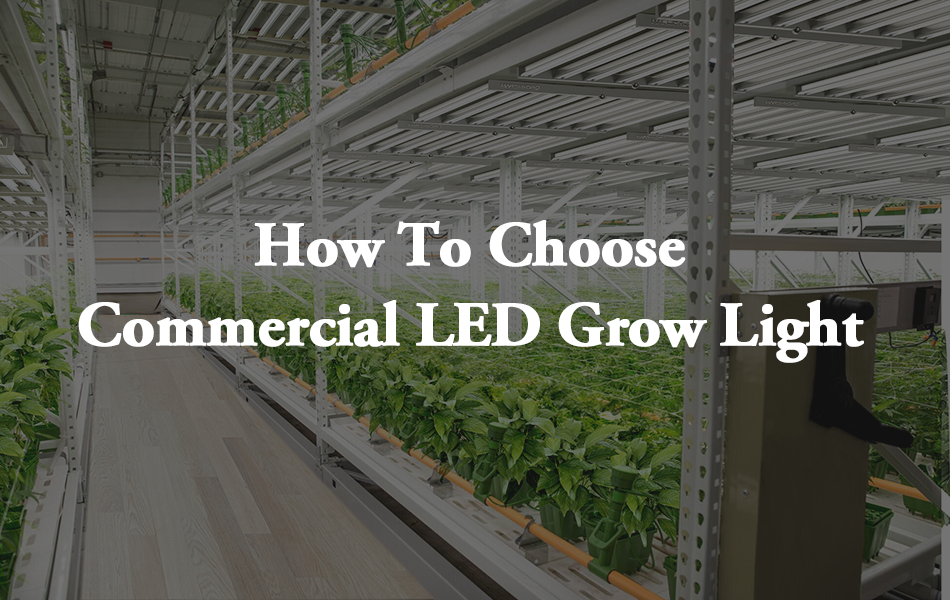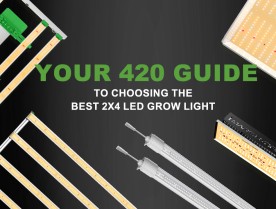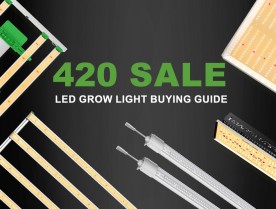
Light is essential for all forms of life on Earth. Sun, the pivotal star in our galaxy The Milky Way, is the source of required light, essential to keep life sustainable on our planet. Autotrophs, the organisms which can produce their food and energy, require ample amounts of light for healthily sustaining their lives. Plants fall in the category of autotrophs and are the most important living things on our planet. One way or another, plants form the backbone of food-chains. To produce food, plants use light from the Sun to perform photosynthesis; a process whereby sunlight, water, and carbon-dioxide are utilized to synthesize energy.
To ensure healthy plant growth and maximize yield, we need to ensure suitable conditions for the plants during their lifetime. One of these conditions is the provision of an ample amount of appropriate light, which the plants can utilize to assimilate food. Our specialty is to offer such lights to the growers, which may significantly assist them in obtaining a better crop; be it an indoor-farm, a greenhouse, a kitchen garden, or a mini-garden inside the home.
- Sources of Grow Lights for Commercial Indoor Farming
Raging from differences in the design of the source to the spectrum of light emitted, there is a vast variety of grow light sources that are available at the disposal of contemporary growers. The most commonly utilized sources, when it comes to commercial cultivation, are the High-Pressure Sodium (HPS) light and the Light-Emitting Diodes (LEDs). Some features of both these lighting sources are detailed below;
- HPS Lights
HPS lights possess an arc tube of sodium metal and aluminum oxide in a vaporized form. The high voltage applied to the tube causes the plasma inside it to glow a bright yellowish color. HPS lights emit light in a limited spectrum, where the yellow and orange wavelengths are more prominent, and to introduce another part of the visible light spectrum, xenon or mercury must be introduced to the arc tube, which emits blue light.
2. Full Spectrum LED grow light
LEDs are p-n junction diodes, which are specifically designed to emit light when voltage is applied across the terminals. The voltage applied across the terminals of LEDs helps in the creation of electron-hole pairs, which get created depending upon the nature of the material. p-type materials produce holes while n-type materials are responsible for producing electrons. After the production of free electrons and holes, LEDs glow when energized electrons combine with holes and assume their low energy state. Due to the nature of the material used in the wafer of LEDs, LEDs can be made to emit the whole spectrum of light, while avoiding the unnecessary wavelengths and focusing on effective spectrum photosynthesis, the more useful ones.
As opposed to the light produced by HPS bulbs, LEDs specialized cultivation purposes are designed to emit more light in the bluish and reddish area of the spectrum of visible light. This blue light helps the plants to grow healthily, increases the development of leaves and roots, and helps strengthen the plants, particularly during the growth period. Red light is vastly responsible for the initiation of the flowering, which then goes on to produce fruits and vegetables etc.
The typical spectrum of visible light, emitted by MARS HYDRO LED grow lights is given in the graph below.
- Which light to choose?
HPS lights have been around since the 20th century and helping farmers for growing plants and cultivars of their choice using more electric power. However, the technology is out-dated and better options have become available for today's farmers. Due to being versatile in their functionality and design, LEDs are rapidly replacing conventional HPS lights. The reasons why a farmer should opt for LEDs rather than traditional light sources are listed below, which may help the reader understand how superior modern LED technology is superseding conventional light sources.
- Spectrum – LEDs are made to emit wavelengths of any desired color from the visible light spectrum, while HPS lights have limitations in this regard. LEDs specified for cultivation emit light that is helpful through all developmental stages of plants.
- Cycling – LEDs are pretty useful if their application requires constant turning on and off, with no warm-up time required. HPS lights may not be helpful in this regard as they may fail or riffle in such applications.
- Dimming – LEDs can be easily dimmed according to the requirement of the plants. HPS lights may prematurely fail if subjected to continuous dimming, as magnetic or electric ballasts are required for the job.
- Directionality – LEDs typically emit light for 180 degrees while HPS bulbs emit light for 360 degrees by design. For targeted areas and high efficiency, LEDs prove advantageous.
- Efficiency – LEDs are very efficient and usually exhibit above 50% input-output efficiency. Being omnidirectional, losses associated with HPS bulbs are high that need more electricity consumption.
- Heat Emission – LEDs emit virtually no heat or if they produce remains often affordable for plants growth while roughly 15% of the power in HPS is lost due to heat emission.
- Failure and Replacement – LEDs come in the form of a panel, and even if one or two LEDs fail, the rest of the device works properly. HPS lamps display an end-of-life phenomenon whereby the whole bulb fails and needs replacement. The LED replacement has a virtually little cost associated with replacements.
- Lifespan – The lifespan of LEDs is longer than any other commercially available light source. Typically, LEDs last for 5-7 years, while HPS bulbs have a lifespan of 1-4 years.
- Lifetime Costs – LEDs have a relatively high installation cost, but viewed through a wider lens, the overall cost of LEDs comes out to be lesser than that of HPS, as LEDs require very low maintenance costs and are extremely energy efficient.
- MARS HYDRO – Commitment to a Brighter Future
MARS HYDRO is dedicated to the provision of easy and affordable lighting solutions for indoor horticulture growers from large commercial growers to hobbyists globally, with warehouses stationed in United States, Canada, Europe, United Kingdom, Australia, Russia, and China. We are enthusiastic to develop more efficient lighting systems, which may assist cultivators in growing quality crops indoors with low light accessibility areas.
MARS HYDRO most lights are CE, RoHS, ETL certified and takes pride in customer satisfaction through the provision of quality products. For over 12 years, MARS HYDRO has been loyal to its cause and the results are supreme satisfaction of customers with better-developed plants and increased yield. Our products come in various sizes and adjustable arrangement options, so that you may grow your plants on shelves, in greenhouses, in indoor-farms, in kitchen gardens, or wherever a grower's heart pleases.
Coming widely categorized as the TS, SP, and FC series, MARS HYDRO offers LED grow light solutions for all sorts of indoor cultivation projects. Given below are some details of the different lighting options, which may help the growers in selecting the lights suitable for the types of growing culture they prefer.
1. FC 6500
With an innovative and flexible design, FC 6500 provides a full spectrum like the sun for the plants to flourish in vertical racking, grow shelves, and hanging arrangements. Equipped with best-Selling Samsung LM301 and Osram 660nm LEDs chips, this light provides high efficiency of about 2.8 umol/J. With a maximum yield of 2.5 g/W, the light helps in the production of 30% more yield as compared to blurple and HPS lights. The no-fan design with an aluminum heat sink helps efficient heat dissipation without producing unnecessary noise. IP65 waterproof setup, with a 180-degree movement margin, FC 6500 lights can also be daisy-chained with multiple lights while a single controller could regulate their working.
FC 6500 covers all the necessary wavelengths needed for effective plant growth. Moreover, the farmers could grow the plants of their choice ensuring increased productivity along with getting quality since it complements plants' requirements throughout the growth period across variable stages.
2. SP 3000 & SP 6500
SP 3000 and SP 6500 can be a better choice for a farmer when it comes to humid environments, especially with taller plants. Equipped with Samsung LM301B and Osram 660nm chips, SP 3000 and SP 6500 comes with thick heat sinks and IP65 waterproof technology. High PPFD estimated at 2.8 umol/J with average yield at 1.8 g/W, SP 3000 and SP6500 helps increase the plants yield 50% more as compared to blurple or HPS lights. Fan-less design ensures no noise in the working environment and the dimmer function helps in the growth of plants by adjusting the intensity levels of light. A thick aluminum heat sink helps regulate the temperature of the growing environment.
Daisy-chain function helps in controlling up to 15 lights with a single control. These lights are added with blue and infrared spectrum wavelength that effectively help plants during seedlings, vegetative, and flowering stages of growth in commercial greenhouses and indoor hydroponic farms and ensure bigger harvests. Both, SP 3000 and SP 6500 are ideal lights if the growers plan to grow plants in their grow rooms.
3. TS 3000
For commercial cultivation, TS 3000 is the ideal choice for indoor growers. The SMD-LED technology with Epistar LED chips, provides 1274 umol/J output, TS 3000 works on the voltage levels of 120VAC, 240VAC, and 277VAC and is suitable for large rooms and commercial setups. With an aluminum hood, light effectively focuses on the targeted area and the intensity is increased up to 20%. The light-weight board, with a fan-less design, significantly reduces noise pollution, to provide a noise-free environment to the plants and the growers. Dimmable mean well drivers help the growers adjust lighting levels according to different growth stages and need of the plants.
With its effective and efficient design, TS 3000 provides the farmer with an almost 30% higher yield as compared to HPS or old LED lights. The yield can be estimated at 2.5 g/watt. With a true output of 450 watts, TS 3000 easily compares to the traditional 600 watts HPS bulb in intensity and is more energy-efficient. Moreover, this LED board is capable of emitting both blue and red wavelengths of light, which are extremely essential for proper plant growth. The biggest advantage comes with cost-effectiveness and the growers could utilize TS 3000 for growing vegetables such as tomatoes, lettuces, peppers, and cucumbers at relatively lower costs than other LED Grow lights of the same capacity.
- Which light is suitable for my setup?
Indoor farming is practiced in several methods, and the farmers need to choose which light could best suit their chosen growing environment and arrangement. As requirements for lighting change with the area under consideration, some suggestions that could help the growers in choosing our product best suited for their needs, are listed below;
1. Indoor grow room/farms of commercial levels – TS 3000
It will provide the farmer with a cost-effective solution for their lighting issue while ensuring the careful growth of plants according to their light needs. They could grow either plants or vegetables of their choice including peppers, tomatoes, lettuces, and cucumbers.
2. Greenhouses – SP 3000, or SP 6500
Since the SP lights excellently deep penetration, it is a better option for the splendid growth of plants for commercial production, especially tall tree plants. And due to SP 6500 high PPFD, add extra co2 level in grow environment, which could help maxim yields
3. Vertical Racking & Shelves – SP 3000, SP 6500, FC 4800 or FC 6500
Due to their flexible adjustment option, all these lights will perform marvelously when dealing with vertical farming, which is a relatively new trend in farming and cultivation. The growers could install any FC lights for getting enhanced production for both plants and greenhouse vegetables culture.






